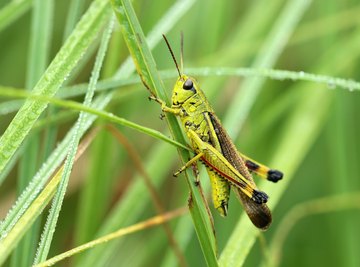
When determining whether a grasshopper is male or female, the answer usually lies in the abdomen. Immediate visual cues are available, but in some instances identifiers are not available. For instance, if you see a grasshopper in the wild, it might hop away before you get the opportunity to see its abdomen, but you can see its size. Similarly, you might have a preserved grasshopper that has lost its color, but you can inspect its anatomy.
Size
Male grasshoppers are unusual in size compared to females. Most males are larger than the females of a species, but female grasshoppers tend to be the bigger of the two. The size difference is apparent in length by a few millimeters and at the thorax, or region behind the head, which is larger overall. The legs of females are longer by a few millimeters, too.
Shape
Male and female grasshoppers have the same approximate shape, but subtle differences exist. The abdomen of the male is rounded and dips into a subtle curve before tapering at a slightly raised angle. The abdomen of the female is straight with no curve. To see this more clearly, look at the grasshopper sideways or hold it up even with your eyes to look at it from the back.
Reproductive Anatomy
The reproductive anatomy of a grasshopper is the most obvious way to tell its sex. Grasshoppers do not preserve well, so if you are looking at one that is no longer alive, its reproductive organs might have disintegrated, but if you can see them at the far end of the abdomen, the answer is clear. Males have a blunt tip that tapers at the end of the abdomen. Females have an opening that creates a profile silhouette of two triangles or flaps, called cercuses or cerci. This is her ovipositor or how she lays eggs. The ovipositor does not taper, but might not remain open, depending on the gestation cycle of the specimen.
Identifying Nymphs
Nymphs, or baby grasshoppers, do not exhibit the external characteristics of adult grasshoppers, so they are harder to identify as male or female. In the wild, this identification will almost always be impossible, unless the nymph is near maturity and beginning to develop adult features. As a preserved specimen, you can dissect the grasshopper to find its reproductive organs. Use forceps to remove all appendages, then use a scalpel to cut the grasshopper open. Males have testes at the far end of the abdomen. They appear as a pale pinkish-beige or yellow-beige sac. You can also see the shape the abdomen will take upon maturity and identify it that way.
References
About the Author
Rachel Moran started writing in 2003. Her journalism has appeared in "Orange," "Luxury," "Creative Loafing," "tbt*" and other publications. Her fiction has appeared in the "Tampa Review," "Florida Review," "BLOW" and "Pindeldyboz." Her copywriting has served clients from Bayer to Volkswagen. Moran received her Bachelor of Arts in writing from the University of Tampa.
